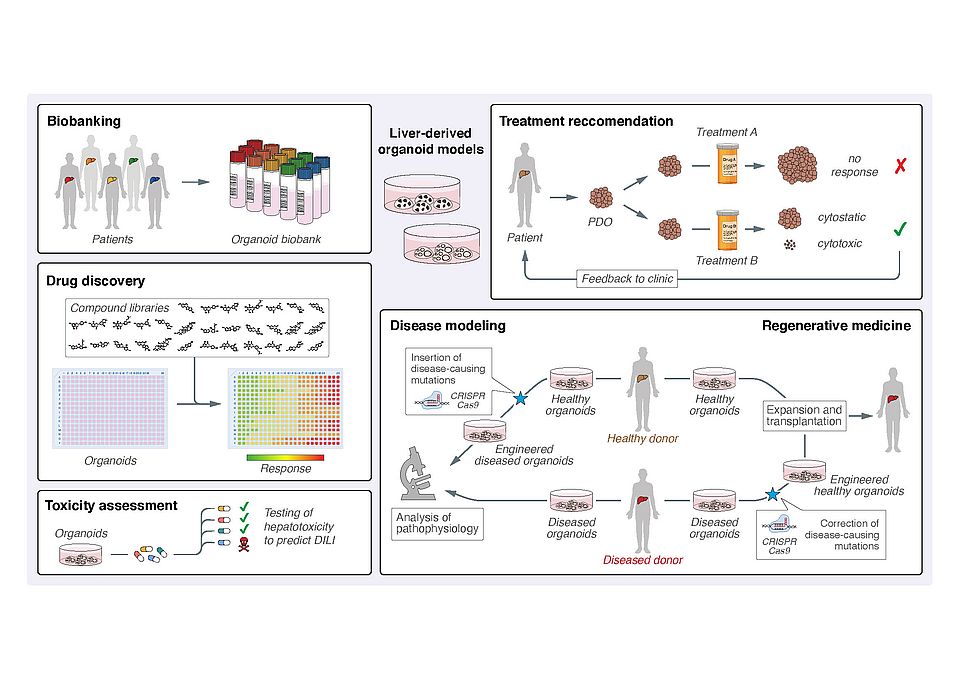Liver Cancer . Organoids . Patient derived xenograft mouse models . Viral Hepatitis . Innate Immunity . Interferon
Hepatology
Hepatocellular Carcinoma and Chronic Hepatitis
Worldwide, liver cancer is the fifth most common cancer and the second most frequent cause of cancer-related death, with an estimated 854,000 new cases and 810,000 deaths per year. 90 % of liver cancers are hepatocellular carcinomas (HCCs). Over 95 % of HCCs develop on the background of chronic liver disease and indeed, more than 80 % of HCCs occur in cirrhotic livers. Treatment options for advanced stage HCCs are still very limited, and a better understanding of the molecular and cellular pathogenesis of HCCs is urgently needed. In the framework of a clinical study protocol we generated a clinically annotated tumor- and liver-biopsy biobank and blood bank. This unique research resource is being used to study the molecular and cellular pathogenesis of HCC with the aim to generate clinically meaningful molecular classifications, to identify predictive biomarkers for response to treatments, and to identify new therapeutic targets and strategies. A major obstacle in preclinical drug development is the lack of appropriate cell culture model systems. Current in vitro cell culture models of HCC are based on conventional hepatoma and hepatocarcinoma cell lines that fail to recapitulate key features of tumor tissues such as three-dimensional tumor architecture, cellular heterogeneity, and cell-cell interactions. We have developed a pipeline to generate and characterize organoid models of HCCs (Nuciforo et al., 2018). These HCC organoids maintain the histological and genomic features of their originating tumors during long-term culturing for up to 32 weeks. The models can be used for preclinical drug screenings and testing and to generate phenotype-genotype correlations tables (Fig. 1). HCC tumor biopsies can also be used to generate xenograft mouse models (Blumer et al., 2019). Again, these models closely resemble the originating tumors and can be serially passaged. Xenograft mouse models preserve the heterogeneity of HCCs and are a valuable research tool for preclinical drug testing.
The most important underlying liver diseases that predispose to HCC are chronic hepatitis B and chronic hepatitis C, alcoholic liver disease, nonalcoholic fatty liver disease, and nonalcoholic steatohepatitis. Our lab has a long-standing research interest in viral hepatitis with a special focus on innate immune responses to viral hepatitis. The host response to hepatitis C is controlled by a genetic polymorphism of the interferon lambda (IFNL) gene locus. Paradoxically, individuals who cannot produce IFNL4 due to a frameshift mutation in the IFNL4 gene have a better immune response to HCV and can control and eliminate the viral infection. On the other side, individuals with a wild-type IFNL4 usually cannot eliminate the virus and develop chronic hepatitis that can lead to cirrhosis, despite a strong induction of hundreds of IFN-stimulated genes (Boldanova et al., 2017). This so called “IFN lambda 4 paradox” is currently not understood, and is a focus of ongoing research in the lab.
Contrary to HCV, hepatitis B virus (HBV) does not stimulate the induction of an interferon response in the liver. Using liver biopsies of patients with HBV infections, we could show that this lack of innate immune response is not due to an active inhibition of sensory pathways or interferon expression by HBV, but because HBV is a “stealth virus”, i. e. HBV is not recognized by pathogen associated molecular patterns (PAMP) receptors, most likely because of a very low expression of cGAS and STING in hepatocytes, two components of the intracellular sensory pathway that detects viral DNA (Suslov et al., 2018; Baumann et al., unpublished). Ongoing projects in the lab investigate the molecular mechanisms that control HBV viral replication in chronic hepatitis B, with a main focus on disease stage transitions during the natural history of chronic hepatitis B.

Fig. 1: Translational applications of liver-derived organoid models. Patient-derived organoid biobanks are important resources for applications in academic research and drug development. Organoid models of liver disease can be directly generated from diseased donors or alternatively from healthy donors following CRISPR/Cas9-mediated insertion of disease-causing mutations, e. g. for the study of monogenic liver diseases or liver cancer. Organoid-based drug discovery allows a more physiological assessment of drug sensitivity and hepatotoxicity facilitating the selection of potent drugs with a safe profile. Patient-derived organoids could support clinicians during the therapy decision-making process by predicting the efficacy of different treatments for the same indication. Finally, organoid-based cell therapies represent an alternative to liver transplantation for various diseases, in particular monogenic liver diseases that can be corrected with genome editing methods. CRISPR/Cas9, clustered regularly interspaced short palindromic repeats/ CRISPR associated protein 9; DILI, drug-induced liver injury; PDO, patient derived organoid.
